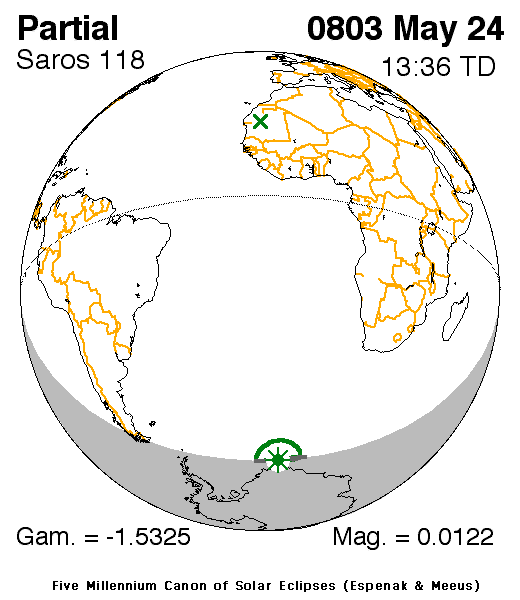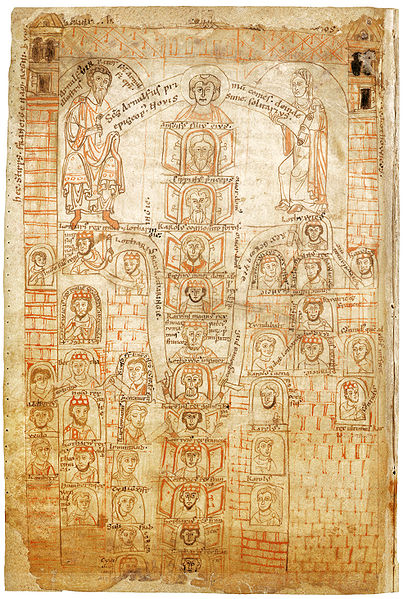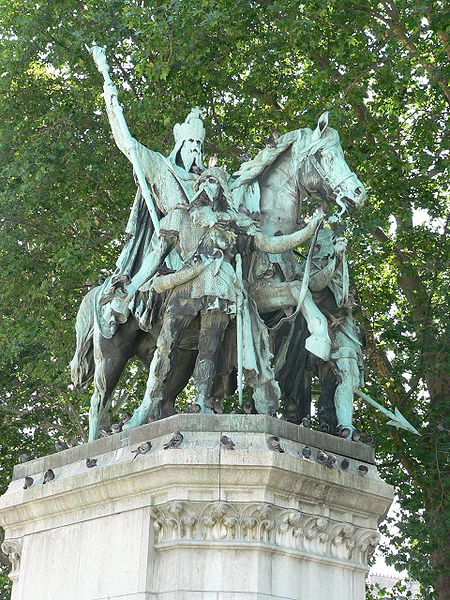This second approach to the energies of the June 1 2011 eclipse focuses on the one initiated by Saros 118 cycle on May 24 803. Decided to go in-depth on this date after gathering some pieces of official history and verifying the following:
- Defined the powers of the Western world for the next 1,200 years
- Incubated the most outstanding milestones in coming centuries
- Power dynamics from then are still reproducing today
 But also, because based on the above mentioned, once again I found what’s written in heavens for this New Moon and Solar Eclipse of June 1 2011 comes out.
But also, because based on the above mentioned, once again I found what’s written in heavens for this New Moon and Solar Eclipse of June 1 2011 comes out.
When the intention to approach all returns for this eclipse cycle was started to look for historical patterns, it was not possible to even complete the last return due to lack of time. However, you can try to do it and share with us. You have the dates of the last three returns in this link and, if you wish to go into previous years you can find them here.
May 24, Year 803
Available information on that year has major gaps, we have more information on Chinese Dynasties 1,200 years prior to that and on previous 2,400 years on Egyptian Dynasties that on IX and X centuries of ‘our era’, which have been named as the ‘Dark Age’ for records and documents from those years is almost non-existent…
We cannot know (hope it’s temporary) what happened on May and less on the 24th. As if not to leave a total void, at least one event was left on records:
- Nicephorus I and Charlemagne established frontiers for their empires
- Hence, the Bizantium Empire recognizes the independence of Venice
- The do it signing the La Pax Nicephori Treaty

Three phrases from a timeline that could say little, but digging a little deeper we can find not only surrounding energies then, but also now.
The Context of the La Pax Nicephori Treaty
- Byzantium Empire had been Christianity bastion to restrain the entry of Islam into the territories of what’s known today as Europe.
- But for the year 803, roles turn upside down and now it’s the Western Roman Empire trying to stop the advances of the Eastern Roman Empire (Byzantium). Both Christian empires.
- Also, Charlemagne crowning in 800 by Pope Leo III, meant the church liberated somehow from the power of the Emperor. A strategy to return power to the papacy in Eastern Europe.
- The Byzantium Empire did not recognize Charlemagne affirming they were not the real descendants of the ‘Roman Empire’ since the beginnings of the church. A schism started, Pope Nicholas I refused to recognized the Patriarch of Constantinople and, the last one accused the Pope of heresy for introducing in the creed the descendants from ‘Father and Son’, the first ones kept only the ‘Father’.
- The issue of descendants was the basis of a power with exclusivities and no one could dispute, usually given by divine right to families fighting for that power even among themselves without considerations.
- Charlemagne was from the Carolingian Dynasty, linage from Frank kings that held power for 200 years with the support of the church that had as strategy to look for protectors among ‘noble’ families in order to extend its own power.
-

Charlemagne | Statue in front of Notre Dame Cathedral | Photographer: Rama | click on image for more info This was a time when the church preached that ‘God created them and if they did his will, they would have eternal life’ (Who knew what God wanted? Ah…) which also maintained a more hopeful supremacy, although possibly it also increased the competence for power, to the extent that rules were invented according to each needs and not exactly with ‘divine’ precepts.
- The battle between iconodulism (veneration of images) and iconoclasm (versus veneration of images). Byzantium leaders were fighting since VIII to maintain veneration.
Outreach of the La Pax Nicephori Treaty
- Peace did not last long, Venice soon after declared part of the Western Roman Empire
- Byzantium ruling started to decay and Carolingians before the end of the century would see their power almost vanished
- Frontiers established by those empires were not definitive either
Outreach of the Energies in the Year 803
However, it’s necessary to remember year 803 is among the splendour years of Charlemagne Empire, which many have interpreted as the cradle of the Western world ongoing for 12 centuries and saw in those years the seeds of:
- What would come to be Europe and the common European identity
- The axis of power for the Western world
- The cult of figures for earthly ‘protection’: kings, knights, heroes, ‘caudillos’…
- Inspiration and justification for the Crusades which also enjoyed the divine precepts and rights
- Powerful institutions, laws and arms to maintain power, such as the Inquisition
- The official consent for invasions and conquering of territories with the Providential ‘by force or reason’
Note: All historical data used here can be found in Wikipedia
:::
Read also:
- Three Eclipses Aproaching: June 1 and 15 | July 1 | 2011
- New Moon and Solar Eclipse June 1 2011 | The Roaring of the Waves
- Eclipse June 15 2011: Origin of the energies in history
- Emanations | Full Moon and Eclipse June 15 2011
- Solar System dispositions for Full Moon and Eclipse June 15 2011